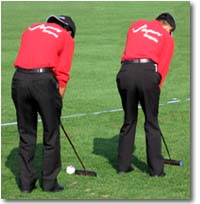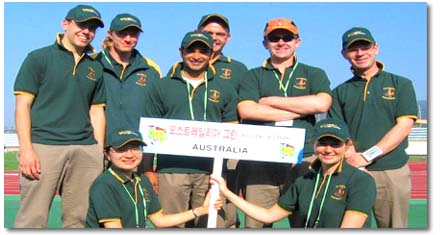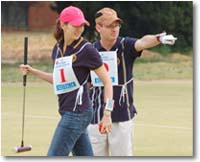

|
Back to |
| The Front Page |
| News & Features |

|
Gateball in Shanghai: Croquet miniaturized, multiplied, and taken up by millions |
|
by Alex Park photos courtesy of Sue Leitinger and Alex Park Posted August 30, 2010
|
With more than 600 players from four continents and a mega-budget, the 2010 World Gateball Championship in Shanghai, China, lays claim to being the biggest mallet sports tournament in the world. In September, 30 Australians in five teams will be competing, each hoping to be the first to survive the initial qualifying round. Australian gateballer Alex Park previews the event for Croquet World Online, and we'll publish a photo story on the championship after it's over. Alex is a product of Croquet Australia's pioneering of a "mallet sports" strategy to embrace and promote many games under a single banner. As a member of the Canberra Croquet Club, he's well qualified to explain the game played by millions to croquet players who number in the mere thousands.

|
| Japanese Gateball players mostly retain their "golf-style" technique, while other Asian teams have begun to adopt the croquet-influenced "centre stance" the Australians have brought to the game. |
In 2010 there are 96 teams representing Australia, Brazil, China, Chinese Taipei, Hong Kong, India, Indonesia, Japan, Macau, Paraguay, the Philippines, South Korea, Russia and the USA. Most of the teams are from China, Japan, South Korea, Brazil and Chinese Taipei with each allocated 12 or more places, based on their respective populations of ranked competitors. Australia, Hong Kong and Macau are all sending five, while India, Paraguay, the Philippines and Russia will complete the blocks with a couple of teams each.
Watch out for Japan and China
| TEAM ALLOCATIONS FOR THE SHANGHAI CHAMPIONSHIPS |
|
Australia 5 Brazil 15 China (host) 14 Hong Kong 5 India 1 Indonesia 2 Japan 15 Macau 5 Paraguay 2 Philippines 2 Russia 2 South Korea 12 Taiwan 12 USA 4 |
This year is also likely to see a strong showing from the local Chinese teams. China now boasts the largest Gateball playing population, estimated in the millions, and competition among 200 players in the national tournament to qualify for the 2010 team was fierce. The Chinese have also won many international tournaments, including the Australian Gateball Championships in 2007.

|
| This nattily-uniformed Australian team at the 2006 World Championship in Jeju, Korea, stood out for their appearance alone - they were among the few Caucasian teams, and comparatively youthful in the field. In 2010, the Aussies aim to qualify for the final rounds with at least one of their five teams. |
Australia's involvement in the World Championships has had a surprising impact on the way Gateball is played. Croquet Australia has godfathered Gateball's widespread introduction to the Australian continent. Because most of the Australian Gateballers were introduced to the game through croquet clubs, most play "croquet style" (front on) rather than the "golf style" (side on) traditionally preferred by the Japanese. Since Australians made their first appearance at the 1998 World Championship - the same year Croquet Australia adopted the "mallet sports" strategy of development - the croquet technique has been spreading throughout the Gateball world, including players in China and Korea who now also play croquet-style.

|
| Like most Australian players introduced to Gateball through affiliated croquet clubs, this one hits centre-style during a Gateball championship on the Canberra Croquet Club courts, in contrast to most Gateball players in Asia who use the traditional "golf-style" side-stroke. |
Tournament structure makes every game vital
As in past World Championships, this year's event will involve a round-robin group stage followed by a single-elimination knockout stage. The format of the tournament means that most teams will play only three matches during the World Championship, which is organized to complete in only three days. A Gateball match lasts only thirty minutes, so three games doesn't yield much playing time.
Nevertheless, the courts are available for teams to practice for three days before the tournament, so there's plenty of time for players to adjust to the courts and get a chance to compete against other teams. And despite the cut-throat nature of the event, it does manage to incorporate 167 matches in just two days of competition.

|
"Sparking" in Gateball is similar to "sending" the ball in the traditional backyard croquet game, but different. It requires the striker to hold down his own striker's ball and to position the "ball-in-hand" just struck to be sent to a targeted point when the striker hits his own ball (a reverse of the ball-in-hand positions in conventional croquet), which must stay in place on the lawn. |
The Shanghai venue impresses more than the courts
| GATEBALL BASICS | |
| • | Gateball is a mallet team sport similar to croquet. |
| • | Played on a rectangular court 20–25 meters long and 15–20 meters wide. |
| • | Each court has three gates and a goal pole. |
| • | The game is played by two teams (red and white) of five players. |
| • | Each player has a numbered ball corresponding to their playing order. The odd-numbered balls are red and the even-numbered balls are white. |
| • | Teams score one point for each ball hit through a gate and two points for hitting the goal pole. |
| • | A game of gateball is timed to last for thirty minutes. |
| • | Players only have ten seconds to complete each shot. the winner is the team with the most points at the end of the game. |
|
For more details see www.gateball.com.au
|
|
It's likely that the lawns will be much rougher and with longer grass that the typical Association-affiliated Western croquet lawns. The last World Championships, in Jeju, South Korea, were played on a soccer oval previously used several months earlier in the 2006 (Football) World Cup. The grass was several centimeters long and the ground uneven in places. Astonishingly, the surface had little impact on the top Asian teams' ability to regularly hit ten- to fifteen-meter shots with apparent ease.
Learning to play on different types of courts and being able to adapt quickly to different conditions is one of the challenges of Gateball. Like tennis, Gateball is played on many different surfaces around the world, including Astroturf, clay, gravel and even, with special equipment, on cement. To prepare for play on longer grass, several Australian teams have been venturing beyond their home croquet clubs to practice.
The referees are professionals - and dashing
Referees are a conspicuous part of any international Gateball tournament. There are up to four officials per court, traditionally dressed in light blue blazers with white gloves to clearly distinguish them from the players, who are required to wear matching uniforms - usually including bright-colored shirts and baseball caps. Each game is overseen by a chief referee, who ensures the game moves quickly by calling each player as his or her turn arrives and enforcing the ten-second rule. The chief referee is supported by an assistant referee, recorder (for scoring) and lines person.
The Championship embrace Olympian-scale spectacle

|
| Teammates discuss tactics while one prepares to "spark" after a touch shot - a "hit-in" or "roquet" in conventional croquet parlance. |
Side meetings will consider changes to the rules
Off the courts there will also be a series of officials' meeting, including a formal session of the World Gateball Union. This year the meeting will be particularly significant, as delegates are voting on a proposal to make illegal the "double touches" currently an integral part of Gateball strategy. There will also be meetings of national organizers to share ideas for promoting Gateball everywhere, including the virgin West.
You can follow the championship online…and on TV! While the championships are unlikely to make much of a splash in Australia, some of the games will be broadcast in Japan through the dedicated Gateball program Super Gateball. The show is a regular feature on a Japanese pay-TV sporting channel and broadcasts the finals as well as interviews with various teams throughout the tournament. In the last championships, one of the Australian teams was interviewed, albeit through two translators (English-Korean, then Korean-Japanese!)

|
A player follows his ball after successfully passing through gate one. The onlooker labeled #6 is a teammate, the tireless and ubiquitous Tony Hall, former president of the World Croquet Federation. In Gateball, the sides alternate play in strict sequence numbered one through ten, with even numbers designating one team and odd the other. The wide wickets allow for some interesting and fun tactics by players aiming long to achieve an advantageous position on the court for subsequent shots. |
Croquet World Online will publish a follow up article about the championship in October. In the meantime, if you want to find out more about the competition, or Gateball in general, you can visit www.gateball.com.au, where you will also find a link to the Australian teams' 2010 World Championship blog.
|
START GATEBALL AT YOUR CROQUET CLUB
|